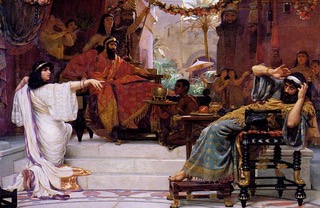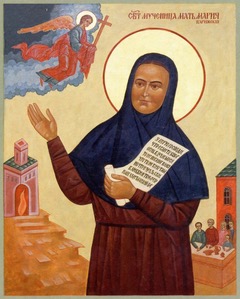 “The End is Near!” proclaims the ubiquitous sign of the doomsday prophet. In the case of Lent Madness 2018, our sign-wielding friend would be correct. Welcome to the Faithful Four. After weeks of learning and voting and debating, the saintly field has been whittled down from 32 to four spiritual heavyweights: Esther, Maria Skobtsova, Anna Alexander, and Richard Hooker.
“The End is Near!” proclaims the ubiquitous sign of the doomsday prophet. In the case of Lent Madness 2018, our sign-wielding friend would be correct. Welcome to the Faithful Four. After weeks of learning and voting and debating, the saintly field has been whittled down from 32 to four spiritual heavyweights: Esther, Maria Skobtsova, Anna Alexander, and Richard Hooker.
As we like to tell our five-year-olds when they join their first soccer team (that’s football for our friends across the pond), “there are no losers, everybody’s a winner.” Of course we’re lying. Thus, while we can sing the praises of these four saintly souls, only one Golden Halo will be awarded.
Today Esther takes on Maria Skobtsova; tomorrow Anna Alexander battles Richard Hooker; and on Spy Wednesday the championship round will take place. For the Faithful Four, we let our remaining Celebrity Bloggers loose as they answer the question “Why should Saint XX win the Golden Halo?” In other words, they’ve been charged with letting us know why their particular saint is so awesome. In this match-up, we have the unique situation of Megan Castellan writing for both Esther and Maria. Oddly enough this is familiar ground for Megan who, in 2015, also had both sides of a Faithful Four matchup in advocating for both Brigid of Kildare and Egeria. Tomorrow Anna Courie is writing for Anna Alexander and Marcus Halley for Richard Hooker.
To make it to the Faithful Four, Esther made it past Lazarus of Bethany, Michael the Archangel, and Peter, while Maria bested Thomas à Kempis, Quiteria, and Martin de Porres. Here’s your chance to send one of these inspiring women off to vie for the Golden Halo.
Esther
 I was introduced to Esther the same way most of us are. She was the pretty, beauty-pageant winner in the book of children’s Bible stories. She seemed glamorous and likable—like the popular cheerleader in high school. It wasn’t until later that I began to see her as a partner-in-crime.
I was introduced to Esther the same way most of us are. She was the pretty, beauty-pageant winner in the book of children’s Bible stories. She seemed glamorous and likable—like the popular cheerleader in high school. It wasn’t until later that I began to see her as a partner-in-crime.
Esther, the only popular biblical heroine who does not fit either the category of mother or reformed prostitute, somehow manages to survive and prosper in a world that sees her at every turn as less than human. Consider the story we know: the king begins his search for a new queen only because Vashti makes the (perfectly reasonable) request to not attend his dinner party so he can show her off. The king picks Esther to marry, not because he loves her, but because she’s the prettiest. So Esther becomes queen, having realized two fundamental things at the exact same time: first, that her worth consists solely in her appearance, and secondly, and most crucially, that will not protect her life from the king’s displeasure.
And yet, in this most dehumanizing situation, Esther steps up and intercedes for her people, valuing their safety and security just as highly as  she prizes her own. In so doing, she became an inspiration and adopted patron to the countless conversos of Spain who were baptized at the end of a sword. Through her aid, they held onto their belief in their own humanity, their faith, and God’s goodness towards them. Esther remained, for them, a sign that God still acted for God’s people even when the truth was shrouded, religion perverted, and all seemed lost.
she prizes her own. In so doing, she became an inspiration and adopted patron to the countless conversos of Spain who were baptized at the end of a sword. Through her aid, they held onto their belief in their own humanity, their faith, and God’s goodness towards them. Esther remained, for them, a sign that God still acted for God’s people even when the truth was shrouded, religion perverted, and all seemed lost.
For us, Esther is an example of faithful leadership. Having made her way into power and privilege, she then uses that privilege in the service of those without it. Esther is a model of leadership through kenosis; a self-emptying leader who risks her life just as she had managed to save it, so that others, too, might be as free as she.
In these turbulent times, may we all be as brave as Queen Esther.
Maria Skobtsova
 Maria Skobtsova was a simple woman, who lived a simple life. She was born in Russia, under the czar, and early on, discovered a passion for art and the life of the mind. She joined the Russian Revolution, but became disenchanted with it soon after.
Maria Skobtsova was a simple woman, who lived a simple life. She was born in Russia, under the czar, and early on, discovered a passion for art and the life of the mind. She joined the Russian Revolution, but became disenchanted with it soon after.
She finally found what she had been searching for in the Church. She studied theology and ultimately took orders as a nun. But what set Maria apart was not her dedication to the church—it was her dedication to the world. When she took her final vows, she required the bishop to make her a promise, that she would never be taken out of the world. For her, serving the people who suffered was the true calling of Christ. That was where she found her greatest call. She frequently ran into trouble with the other nuns and priests she brought to her boarding house in Paris, because she would skip the daily prayers in order to attend to some emergency with someone off the street. She was notorious for her stubbornness, but she persisted, replying “At the Last Judgment I will not be asked whether I satisfactorily practiced asceticism, nor how many bows I have made before the divine altar. I will be asked whether I fed the hungry, clothed the naked, visited the sick, and the prisoner in his jail. That is all I will be asked.”
Maria lived such a dedicated and passionate life that it is difficult to sum it up briefly. She was, above all, clear in her calling and in her purpose, ![]() even when it confused and confounded everyone else, including her own Church. When she found the sick, she nursed them; when she found the homeless, she housed them. When the Nazis began rounding up Jews for deportation, Maria snuck into the Vélodôme d’Hiver in Paris and brought them food, and falsified baptismal certificates. At every point in her life, it was clear that she knew the call of Christ, and nothing, not society, not the church bureaucracy, and not even Hitler’s legions, would stop her from following.
even when it confused and confounded everyone else, including her own Church. When she found the sick, she nursed them; when she found the homeless, she housed them. When the Nazis began rounding up Jews for deportation, Maria snuck into the Vélodôme d’Hiver in Paris and brought them food, and falsified baptismal certificates. At every point in her life, it was clear that she knew the call of Christ, and nothing, not society, not the church bureaucracy, and not even Hitler’s legions, would stop her from following.
Sadly, there were not many following Maria’s path during the Nazi occupation. Far too many Christians chose silence and denial to survive, rather than courageous resistance for the sake of the gospel. Yet Maria shows us just how powerful one person’s act of sacrifice can be. While in the moment, it may seem to have been in vain, if Maria’s life can shine a light for us in our day, then she will have accomplished something magnificent.
[poll id="233"]
180 comments on “Esther vs. Maria Skobtsova”
Maria took seriously her vows and served those in need one by one whereas Esther used her looks and wiles to save her people. The spectre of danger was one element that influenced my final decision. Maria was not a destroyer no matter the sins of the oppressors as was Esther.
This was so hard to choose in this last round. Both authors did an excellent job of describing why "their" saint should receive the Golden Halo. Kudos to both bloggers! I am so conflicted; but because I, too, had a childhood book featuring Esther, I am casting my vote today for the lesser know Maria that her good works and life may shine. Thank you for the wonderful writeups!!
Megan Castellan wrote both posts today!
Voted for Esther but Maria may take the Golden Halo.
I love Esther, and she is the saint for me, but Maria is also awesome.
onward....
Esther for the Halo.
I read “Esther” first and figured she has taken me with this: “Through her aid, they held onto their belief in their own humanity, their faith, and God’s goodness towards them.“
But then Maria....we should all strive for such bravery of heart and soul.
The writing for both was superb, Megan!
Maria for me since she followed Jesus's example so dearly.
This was undoubtedly the hardest Lent Madness choice for me in two years of participating. Both are completely deserving of winning the Golden Halo. Either way it goes, I'm happy. Thank God for both of them.
I loved them both. Both were brave and stubborn and did not fear death. I ended up going with St. Maria because she defied and challenged the entire idea of what was acceptable to do as a nun. Her truth was strong and clear and that’s what she followed. Not rules made by man. A true rebel, a warrior and a superstar in my eyes.
"But what set Maria apart was not her dedication to the church—it was her dedication to the world. " I love this.
Maria is amazing, but Esther has captured my imagination this year and got my vote again. I wish it were a closer race at least.
I agree 100%. I kind of want Esther for the Golden Halo. The funny thing is these two women are sort of one and the same. I'm surprised the race isn't closer.
Sadly, it's a good year for women who brandish crosses in fascists' faces.
If Esther was reincarnated, she would have been Maria.
Ugh, I wish this were the final match up! Both of these women risked their lives to save people.
I should have said, I wish this was the final match up.
Maria’s going to look awesome on my mug this year!
Maria was more courageous than Esther because she had less power but still perserver.
Tough job for Megan this morning, writing on behalf of both candidates. Unfortunately, the first painting for Esther reminds me too much of George de la Tour's painting, Le Tricheur à l’As de Carreau (The Cheater with the Ace of Diamonds). Esther looks as if she's helping to set up the disconcerted pigeon in a card game. And the second looks melodramatic and fleshy, like Delacroix's Death of Sardanapalus. There are a lot of flesh pots in Esther's story. I am swayed by the icons in Maria's defense. And I love her determination to live out her call on her own terms, disconcerting her church at every step of the way. Vive Marie.
Good matches to the paintings! The second one made me think of Cleopatra...
I wonder about Maria: If she didn't like the details of being a nun, why did she continue in that vocation?
I have to go with Maria. A woman who stood up to the Nazis when many Christians in her day turned a blind eye or were even complicit with them. The Sunday School stories of Esther were nice, but somehow Maria's contemporary witness strikes more of a cord with me in our current tumultuous world. Who among us may be the Maria of our day?
While Esther is a worthwhile example of courage and knowing how to pull the levers of power, Maria had a life long service to others. In a time when churches in the West are facing membership and attendance decline, a turn to more service to others without regard to statistics is refreshing.As she said what will be asked of us on the day of judgement, is did we feed the poor, clothe the naked, etc., not how many were in church in a Sunday.
So often these past few years, the winner is a modern figure brought forward from spiritual oblivion. This year, we should remember those classic heroes who paved the way for people like Maria. Go, Esther!
Voting for Maria in honor of Lent Madness, which has introduced me over the last few years to several revered and inspiring people (saints) I had not know about before participating in this somewhat wacky Lenten devotion. And bravo to Megan Castellan for both profiles today.
I picked Maria to win it all, and I'm so excited that so many others have fallen in love with her as well!
Now what I'd really love to see is Anna crush Richard tomorrow for an all women Golden Halo face-off!
For Esther: for all those forced to convert at the tip of a sword or a gun.
Maria, you had me at "At the Last Judgment I will not be asked whether I satisfactorily practiced asceticism, nor how many bows I have made before the divine altar. I will be asked whether I fed the hungry, clothed the naked, visited the sick, and the prisoner in his jail. That is all I will be asked.”
Amen, Loretta
Good job Megan. I'd like to vote for you. (but voted for Maria.)
I will probably lose my bracket - I changed my vote and went with Maria - proud of both of these ladies!
I voted for all four of these from day one. Queen Esther has never seemed saintly to me, but she was better than her opposition. Until now. I've tried to give her careful consideration, lest I fall into the modern saint category. So, I pondered who would Queen Esther be in modern times--living like--well, a queen. That's not working for me. I've always been a Mathew 25 nut. At this particular time in history, it seems all too clear to me that now is the time to act like Maria. Our only excuse is fear. Most of my Episcopal friends, and then some, marched Saturday. My home page was filled with my people marching. There is work to be done. Maria. I can't wait to see what Marcus Hailey and Anna Courie write! Thanks for fantastic blogs today.
How to choose? They are both women who put their lives on the line to save Jews, so it seems like a balanced bracket. I cannot articulate why, originally, I felt compelled to vote for Queen Esther. Does she carry more importance because she’s in the Bible? Is Maria too modern and contemporary to carry the same weight? Does that make Queen Esther more unique? I don’t know.
However, after reading all of the objections to Esther in the ‘comments,’ I realized I’d overlooked the dark side of the Esther story. I’d always assumed the mass murder of the Jewish enemies came from the King, which, of course, it did. But Queen Esther had requested such a slaughter!
I doubt Maria would have killed anyone.
Thank you, fellow commentators, for prompting me to look more deeply into the Esther story. Like many, I’d stopped at her saving the Jewish people without looking at the atrocity that followed.
So, my vote will be for Maria.
How many other times are the stories told, in the Bible, of "good" people like prophets ordering the slaughter of their enemies?
Both risked their lives for the sake of the Jewish people, but Ester took a lot of prompting from Her uncle, and the kn while Maria went out apparently against the will of those who should have been supporting her.
I''m a bit surprised that no one seems to have mentioned [or did I miss it?] that Esther is widely considered as an example of historical fiction, while Maria's historicity is well attested. I have always loved the story of Esther anyway, and so am voting for her, but should be neither surprised nor disappointed if Maria wins this round.
Someone did mention that about Esther in an earlier round, but I imagine no one wants to believe it . . .I voted for Maria.
You missed it! It was widely circulated in the earlier rounds. As Christians we are exposed to and expected to believe so many myths and legends and truths that are not facts, I fail to see what the problem is with the Esther truth if Esther is indeed not "real" but I guess I'm just funny that way.
Who cares who wins - they are both great. It is Ms. Castellan who speaks for them both who I find so admirable.